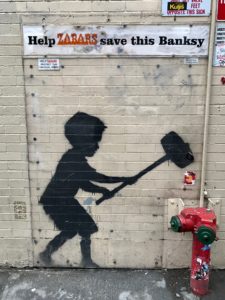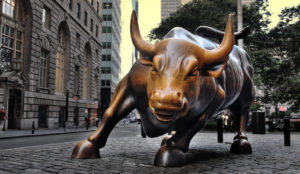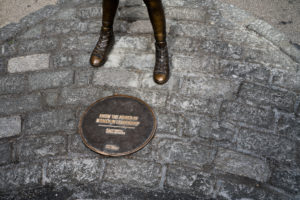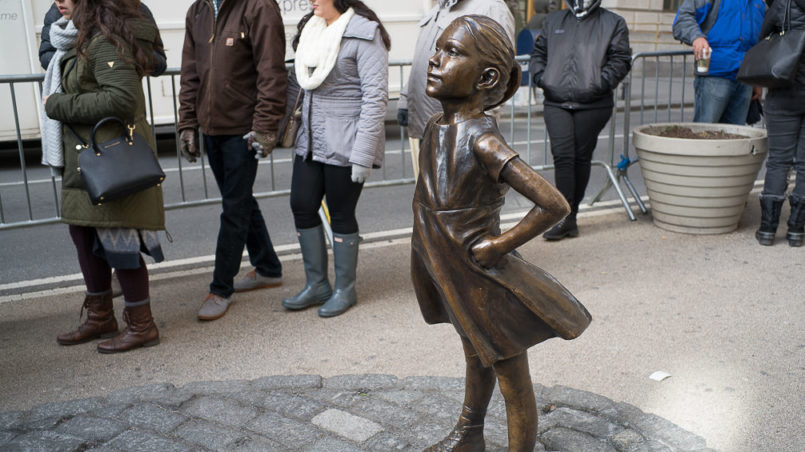Arturo Di Modica, creator of the Wall Street Bull, is upset. There’s a 4’2” girl standing in front of his 7000 pound bull and he wants her to go away. He claims that she’s turned his capitalist bull into something negative and that unlike his guerrilla art, Fearless Girl is marketing because she was paid for by financial giant State Street Global.
But Di Modica’s no anonymous graffiti artist sneaking in after hours to make his mark. He’s even not Banksy. He’s a white man who could afford to cast and tran sport a massive statue at his own expense. In 1989, when the median household income in New York City was $38,293, Di Modica spent $350,000 on his “guerrilla art.”
sport a massive statue at his own expense. In 1989, when the median household income in New York City was $38,293, Di Modica spent $350,000 on his “guerrilla art.”
That same year, Melanie Griffith starred as a Wall Street Cinderella in Working Girl with Harrison Ford playing Prince Charming. “Executive Assistant” was a new term. Most women working in the financial district were still called “secretaries.” And 600,000 women showed up in Washington to for the March for Women’s Equality.
That’s the world the Bull arrived in, but times have changed. It’s not just rich, white men who get to make a statement. Women have money and they’re willing to use it to promote their own agenda. too.
But if the girl doesn’t move on, Di Modica says he’ll sue. He’s protecting his copyright. He’s brought in the lawyers. In the past, he has sued both Walmart and Random House for copyright infringement when the companies used the image of his bull. Both cases were settled out of court. In the current situation, “I don’t think he has a case,” copyright expert David Newhoff explained in his recent piece, Can “Charging Bull” Artist Have “Fearless Girl” Removed?
The thing is, up until this point, Di Modica’s never been shy about the relationship of art, marketing, and commerce. In 1998, he offered to sell the Wall Street Bull for $2 million if the buyer agreed to donate it to the city. Presumably, the buyer would get some sort of plaque similar to the SHE Index Fund’s at the feet of the Fearless Girl. In 2004, the price tag rose $5 million. “[The price] is just for that piece, not the license,” the artist told The New York Daily News. “That bull is one of an edition of five. I’m hoping the other four will be going to cities all over the world, whenever somebody buys them.”
to the SHE Index Fund’s at the feet of the Fearless Girl. In 2004, the price tag rose $5 million. “[The price] is just for that piece, not the license,” the artist told The New York Daily News. “That bull is one of an edition of five. I’m hoping the other four will be going to cities all over the world, whenever somebody buys them.”
Although the New York bull has never been sold, Di Modica has installed versions of the bull in Shanghai and Amsterdam for undisclosed amounts and created numerous smaller replicas. You can buy an 8 1/2 inch one from him online for $38.95.
I’m not saying that artists shouldn’t be paid for their work. Of course they should be. But is Di Modica’s self-marketing any more pure than State Street’s marketing?
Art – big art, public art – generally costs money. It has to be financed by somebody and that somebody usually has an agenda. Even Michelangelo’s David was commissioned by the City of Florence to represent the city-state’s independence and strength against its more powerful neighbors.
Like David, the Bull is male in every sense of the word. Created by men, paid for by men, and intended to promote male dominance right down to the testicles. The Wall Street Bulls balls have been rubbed so often, both for luck and fun, that the patina has worn off and they’re golden.
And then this little girl shows up. Yes, she’s an insider. She’s infiltrated the power structure. Her agenda is encouraging other women to do the same, both in their professional lives and with their investment choices.
If Di Modica never wanted his Bull to be used as a metaphor, he shouldn’t have dumped it on Wall Street. Public art is public, after all. The Bull has become a symbol of New York’s Financial District and, by extension, capitalism. Being in opposition to the bull is a way of critiquing the financial industry, whether that criticism comes from inside or outside. Occupy Wall Street literally started at the feet of that bull. (The protest was moved to Zuccotti Park when it outgrew the space). The Adbusters poster promoting the Occupy protest featured a ballerina in arabesque on the back of the bull.
Is State Street trying to bring down capitalism? Of course not. But just because you don’t want to tear down the system doesn’t mean that you give up your right to criticize it.
Wall Street is still primarily male and white, according to Business Insider, except for “the female-dominated… technicians, sales workers, administrative support, craft workers, and operatives.” Melanie Griffith is taking on supporting roles in television and film, while Harrison Ford gets to revisit Indiana Jones and Han Solo. And of course, women are still marching on Washington.
 But women also have enough power in the financial industry to establish index funds, like SHE, that invest in businesses that support women. And women have enough affluence to put up a little statue that pisses off a big bully.
But women also have enough power in the financial industry to establish index funds, like SHE, that invest in businesses that support women. And women have enough affluence to put up a little statue that pisses off a big bully.



I love it. Perfect last line.